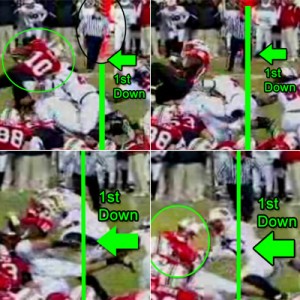“A sideline video camera angle revealed that Adams never reached the first down marker. In fact, he wasn’t even close before his forward progress was stopped by the Wolfpack defense.”
My beef is not with the spot Maryland was given, but who is giving it!
You have a line judge viewing the play from at least 70 feet away making the determination of how far the ball carrier gained. If you haven’t noticed, most officials are in the eyeglass wearing age category yet they need to have microscopic detail from 70 plus feet away on plays like this. Its absurd!
When the runner is downed inside the hash why can’t the referee who is standing RIGHT OVER THE BALL make the spot!
It seems logical that the person closest to the action could make the best determination, right?
This need for a rule change on who spots the ball is further evidenced on goalline plays where, again, a referee must run in 70-80 feet to determine if the ball carrier crossed the plane. While the eyeglass wearing, 50 year old official is running in to make the call players are eye gouging, clawing, and pushing.




You must be logged in to post a comment.